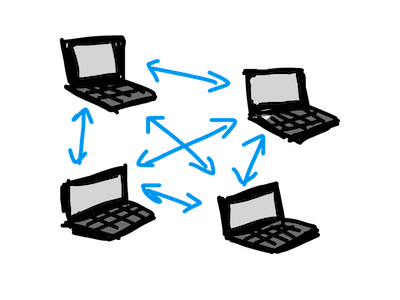The following is a Plus Edition article, written by and copyright by Dick Eastman.
One of the big challenges in genealogy software is sharing of data when two or more researchers are working on the same family. The most common scenario is when each person has his or her own genealogy database. However, as different members of the project discover new data and enter it into their own databases, how does the information automatically get updated to others without requiring each person in the project to manually re-enter the same data?
The quick answer is “via GEDCOM files.” However, anyone who has ever tried this way of merging small bits of information from multiple researchers into the database of each participant can tell you that it is no small task. GEDCOM was designed for a one-time data import. While possible, it is difficult to use GEDCOM for frequent small updates.
Luckily there is an easier method of sharing genealogy databases. Anyone with a Windows, Macintosh, or Linux system can set up a private file-sharing network. For the remainder of this article, I will focus on Windows solutions. However, similar programs are available for Mac and Linux systems as well.
By using a file-sharing program, you and your cohorts can establish a private, encrypted network across the Internet. The only people who can access the data are the ones to whom you grant access. All data is fully encrypted and protected by user IDs and passwords. The more popular methods are free of charge.
 File-sharing programs are as also called “peer-to-peer” networks, or simply P2P. In this case, peer-to-peer means that there is no central file server involved. Each participant’s computer can exchange data with every other participant’s computer across the Internet, assuming that each computer’s owner gives access to the other participants. In fact, the menus allow each owner to share as much or as little data as he or she wishes. For this discussion, I will assume that the owner of each computer has decided to share either one file or one entire subdirectory although other options are available.
File-sharing programs are as also called “peer-to-peer” networks, or simply P2P. In this case, peer-to-peer means that there is no central file server involved. Each participant’s computer can exchange data with every other participant’s computer across the Internet, assuming that each computer’s owner gives access to the other participants. In fact, the menus allow each owner to share as much or as little data as he or she wishes. For this discussion, I will assume that the owner of each computer has decided to share either one file or one entire subdirectory although other options are available.
P2P networks became popular with the original Napster music-sharing network. Napster’s success spawned hundreds of other P2P networks , many of them with far more powerful capabilities than the original network. Many of the early networks were used for illicit activities, such as sharing copyrighted music, videos, and other content. However, as the software has matured, P2P networks have become “legit.” To be sure, a few wide-open networks still exist and are anonymously sharing files against the terms of copyrights, licenses and laws. However, newer, private P2P networks have become respectable; they can respect copyrights and laws. In fact, P2P networks are now becoming useful in corporations as well as for personal use.
You can install a P2P application in your computer and then designate what files will be made available to others as well as to whom they are available. You can share photographs, documents, and even genealogy databases. Yes, you can even share copyrighted materials, but all of that is under your private control. You are responsible for all material that you share.
Anyone who is to be allowed onto your private P2P network will need to install the same software on his or her computer. Once installed and logged on, the individuals you allow into your network can access the files you make available. Conversely, you can access the files that they decide to share, if any. All participants must have an Internet connection at the time they are sharing data. However, these networks work well on dial-up as well as broadband connections.
“Wait a minute,” you say. “Can’t I do the same if I set up an FTP server on the Internet?” The answer is, “Yes, you can -- if you’re more technical.” You can create FTP or Web servers if you have the knowledge required. However, such servers require a knowledge of Web technology and at least moderate skills at configuring servers. Establishing a P2P network is far simpler -- so simple that most non-gurus can create such a network within minutes without assistance.
You can also find some public file-sharing networks that run on some company’s server. These may be free or charge a modest amount. Most of the ones I have seen insert obnoxious pop-up ads all over the place. They also limit you as to how many megabytes you can share. The private P2P networks described here will not display pop-ups, and file sizes are limited only by the space on your hard drive.
The remainder of this article is reserved for Plus Edition subscribers only. If you have a Plus Edition subscription, you may read the full article at: https://eogn.com/(*)-Plus-Edition-News-Articles/12938393.
If you are not yet a Plus Edition subscriber, you can learn more about such subscriptions and even upgrade to a Plus Edition subscription immediately at https://eogn.com/page-18077.
 Latest News Articles
Latest News Articles If you do not see a Plus Sign that is labeled "Add comment," you will need to upgrade to either a (FREE) Standard Edition or a (paid) Plus Edition subscription
If you do not see a Plus Sign that is labeled "Add comment," you will need to upgrade to either a (FREE) Standard Edition or a (paid) Plus Edition subscription